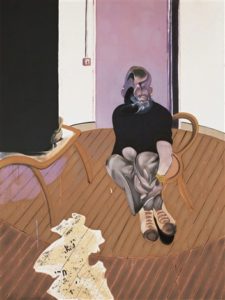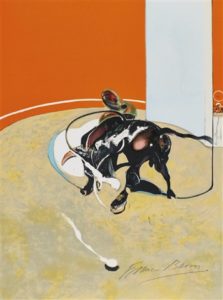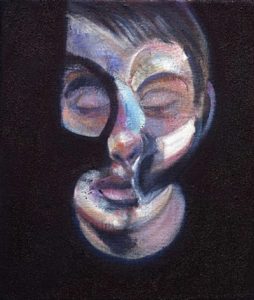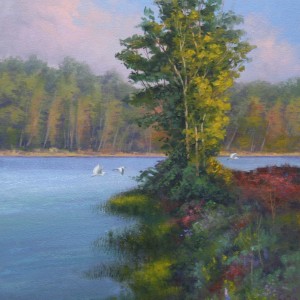Dear Artist,
Last night, Catherine Stock of Rignac, France wrote, “I wonder if you could write a letter on how to elevate one’s work beyond the “So what?” level. That’s where I’m stuck. I can draw and paint pretty well, but–so what? I would imagine there are a few of us out there with this problem.” Thanks, Catherine.
You’re right. “So what?” is universal and as insidious as studio termites. Here are a few thoughts: Deus ex machina, according to Wikipedia, means “God from the machine.” It’s a literary and theatrical plot device whereby a seemingly unsolvable problem is suddenly and abruptly solved with the contrived and unexpected intervention of some new event, character, ability, or object. Roughly translated as “God made it happen,” it’s primarily used to move the story forward when a writer has “painted himself into a corner.” Using this concept, you need to ask yourself what extraordinary thing could be made to happen in your picture. It could be, among many things, a burst of light or an unlikely inclusion. You need to think of something just a bit magical. An engagement of imagination brings a shot of emotion, drama or surprise. This visual epiphany, devised or not, is key to entering the sensibilities of others. Artists who merely rest on their drawing or other facility are forever condemned to the back room.
Another valuable blah-reducing ploy is to do inventive things with your surfaces. This might include adding crusty impasto (a la Lucien Freud), flinty fidges of gradation and zip, (a la Paul Cezanne) or smears and smudges (a la Francis Bacon). But it’s the nuances you invent and make yourself — embedded in your processes — that neutralize creative boredom and give energy to carry on. “This is mine” chisels out your claim. Your embellishment may not even be very good, but it will be yours. “A poor thing, but my own,” is a line attributed to Shakespeare. A unique design, mannerism, or touch of your own is worth more than any rich thing that belongs to someone else.
Best regards,
Robert
PS: “A work of art is the unique result of a unique temperament. Its beauty comes from the fact that the author is what he is.” (Oscar Wilde)
Esoterica: There’s a natural human tendency to lean on and repeat that which we do well. This is okay if we’re cranking out donuts or widgets. But as self-anointed creative artists, our daily joy and progress rest on our ability to jump beyond our safety. Look steadily and imaginatively at the blah in front of you. Given time and contemplation, your new level will stealthily appear. When “So what?” strikes, we ask ourselves “What now?”
This letter was originally published as “Beyond ‘so what?’” on October 5, 2012.
Have you considered a Premium Artist Listing? With each letter, an artist is featured at the bottom of this page. The Premium Artist Listings are a means of connecting artist subscribers through their work. Proceeds from each listing contribute to the production of The Painter’s Keys.
“Common objects become strangely uncommon when removed from their context and ordinary ways of being seen.” (Wayne Thiebaud)








26 Comments
I am so sick of politics!! How disappointing to open painters keys and see an add for Trump wrist bands!!
My art pages are my safe places, please, no politics.
I didn’t get that ad. Google must have thought you would be interested.
No trump wristbands on my feed, thank goodness! I suggest that Sara has little or no control over ad content, and that they are served to the site randomly. I could be wrong though.
Hi, Shari, I got an ad from Sotheby’s when I opened Sara’s.
What we all get in terms of ads is determined by the things we say in emails, click on on the Internet in general, and in particular post and share on Facebook. A couple of days ago I wrote a particular random word in a private discussion in an email, sent it, and within seconds the next pages I opened either in email or on the Internet had ads of that word/item.
If you send/post Trumpian (or other politically-oriented) ranty-rants then that’s what you’ll get. I’ve noticed the more I ignore Trumpian posts of any description on FB/elsewhere, the fewer show up in my feed.
Now that I’ve mentioned the cursed word, I expect a deluge momentarily.
Your pages advertise special things chosen just for you! The add for me was how to fix bad knees. I remember my Mother reminding us to go do things between the television commercials. Art is the key, keep your mind off the stuff on the edges.
I didn’t get the ad either.
Shari, I assure you that The Painters Keys has no control over the ads that show up. The ad I see is for yoga wear.
The ads are usually derived from the cookies and adware that are placed on your device by your specific browser – Chrome is the worst about this – so at some point you may have visited some website that offloaded a rogue cookie. It happens. Please don’t let that take away from the excellent writing and inspirational messages for artists that appear front and center… or maybe a bit to the literal left (smile)
As I have said to our employees, more than once, “what makes us special”? If the answer is nothing it is time to rethink where and who you are. I also say everyone makes a decision to be where they are. Sometimes the decision is not to address an issue but it still is a decision. The Japanese say the efforts of your ancestors were all made to put you are.
I once had a very fine teacher who ask what my goals were and I just rattled them off. He said write them down and of course I said why when they are here, pointing to my head. His response was something nice happens when you write them down they come true. Tried it, Works!!
This is a very good read and good points to keep at the fingertips. But if applied towards the end of the process may appear as add-ons, patches. At the beginning of the development, or early on the way, it is worthwhile to consider possibilities for addition later. Then, too, there is the process for which thinking is not relevant and the tools and materials need only a hand to hold them. Overall, I really like the letter. The idea is to like what we do. Thanks.
Timely letter on a dark, blustery day for a demoralized painter who often wonders, “Why does the world need another painting?” Back to playing with paint!
In these trying times, it’s important to consider–and remember–another aspect of making our art. Get better, yes. Fine your distinctive and unique story, yes. But we make our creative work because something in us yearns to do that. First, the practice gets in “the zone”, which is soothing. Second, we get restored to our ‘happy place’, so we can deal with the rest of the stuff in our life. Third, we share it with others, who get joy from it. Last, it’s a powerful way of having our voice in the world. If it’s all about being “the best” or “making lots of money”, well, that’s nothing to sneeze at. But in times past, when certain genders, religions, races, etc. weren’t deemed worthy of making art (or music, or dance, or writing poetry, or stories, and on and on and on), having the personal freedom to do the work we feel born to do, is not trivial. And having even easier ways of getting our work into the world, on our website, in our email newslettes, on other social media, is pretty empowering, too.
Thank you for reminding us that the world allowed only certain classes, genders, races, and other groupings to make their art publicly. My use of “the world” can be attributed to individual institutions and/or political leaders mostly, sometimes the Art Establishment itself. However, we artists must continue to advocate in the present day for those others who are marginalized because of the aforementioned pressures, not because of their Art.
E
Thank you, thank you, thank you, Catherine, for asking this question and to Sara for finding the response in you dad’s letters. This is a question I have been asking myself.
I am beginning to reach beyond what is familiar but it is scary. The key is to continually ask “What is the worst thing that could happen if…..”
It might mean lots of stuff get put in the reject pile but one or two will convey magic
I love the notion of – what now? The point Robert makes that progress rests “on our ability to jump beyond our safety.” This is the tension held for me between strengthening and mastering skills and taking that next stretch to even better express what it is I want to say on a canvas. To step into the unknown and go farther than anyone has before is my desire and has kept me at the easel in varying degrees for most of my life. My skin tingles just thinking about it! The words of Rainer Marie Rilke in Letters on Cézanne come to mind – “After all, works of art are always the result of one’s having been in danger, of having gone through an experience all the way to the end, where no one can go any further.” If I do not have this feeling by the time I am finished a work then I know I have fallen short of my own potential. It has nothing to with the art being good or great and everything to do with how daring, how courageous and how open and vulnerable I have been as I stood working at my easel. This is the only thing I ask of myself. The results must take care of themselves.
Yes, good timing read for sure, thank you! I am in a bit of a post-show drop right now, having trouble dragging that spark back into my inspiration brain file. What I do know, tho, is some of my best works came to me while using a terrible photo where I had to make it up on my own. I think this is the key to remember. Works that I feel most satisfied with done in the past virtually came from me, and not the camera. Hope this post-show drop subsides soon so I can find another bad photo again. :)
I have a few paintings that have me kind of stuck. Fortunately this letter came along and I see that I will try something different. I forgot to put my intuitive jacket on, the subject matter is upsetting to me and I was trying to work through the painting logically. Hard to do because the subject matter made no sense. I will look at them with new eyes and everything will fall into place. Thanks for the message, it helped me a lot.
MY AD WAS FOR SKIN CARE FROM THE COMPANY FROM WHICH I HAD JUST PLACED AN ORDER.
ADS ARE A SMALL PRICE TO PAY (FREE) FOR ENJOYING “THE PAINTERS KEYS” FOR FREE!
This was an interesting letter to me. Thanks to our beloved mentor John Leonard’s (RCA) continuing mantra to me to “keep going”, I was able to develop a recognizable ‘style’ in my abstracted landscape artwork early on. I remember one artist saying of a piece near the beginning of this large body of work “why the heck did you put that ‘blob’ of red paint there?” Well we talked about that blob for quite some time. And John came along and we talked some more. The fact is that blob started a conversation and kept the viewer looking at the picture longer. Isn’t that what we want? For the viewer to keep finding things to look at? Something perhaps unexpected?
Because I use a black underpainting, most of my colours are reduced in intensity, lest it look like a painting on black velvet!! But an intense patch in each painting, sometimes matching the value with the surrounding area, brings a spark as Robert says. Something in addition to talk about, think about, gaze after. Sometimes, I almost forget my signature ‘juice’ and wonder why the painting doesn’t look finished yet.
This is what I do, what do you do? Find something that you love to do that adds spark (or makes the viewer question what they are looking at) and do it in each work in different ways and places. No one will die.
“A poor thing, but my own.” Brilliant! This will forever be my motto when feeling low, off, down, or out. Thank you!!!
I enjoyed this posting too. I’m still trying to find a style. Maybe this will push me in a different direction.
One short comment. One of the David Hockney films had him painting the woods/field. When he first walked up to where he was setting up, he saw a pile of garbage at an informal dump with refrigerator tossed, etc. He said, “Looks like Francis Bacon was here.” Or, Luciene Freud? One of them…I just thought I’d share. :)
Pingback: Just Keep Practicing - Thistle Designs
We as artists all feel stuck at various times. But like so many artists I kept plugging away at what I always did because with lessons to prepare for and give, and commissions at do, and new work to create I didn’t have time to grow. The break created by the pandemic gave me time to “refuel”. The amount of virtual workshops, tutorial, and even virtual conventions on the internet with fresh ideas and the time to explore and experiment was a god sent in many ways. Being open to opportunities to learn and get you out of the doldrums so many have found themselves in. It’s been easy to be depressed. It takes effort to get back to picking up that brush again. But there’s a world of inspiration out there we can plug into and reconnect with.
I am subscribed but NEVER get the newsletter. So wish you could figure that out.
“You have to have confidence amounting to arrogance, because particularly at the beginning, you’re making something that nobody has asked you to make”, Elaine de Kooning, Ninth Street Women by Mary Gabriel.
I’m trying to follow David Hockneys advice: “ just observe” while I draw a lot and
translate it into my own sad attempts to be original in my paintings. The world is hurling a million images a minute at us right now. As artists, it’s hard not to be tempted by this wealth of visual digital data streaming before our eyes.
A great letter!